- Home
- »
- Medical Devices
- »
-
Hemostasis & Tissue Sealing Agents Market Report, 2030GVR Report cover
![Hemostasis & Tissue Sealing Agents Market Size, Share & Trends Report]()
Hemostasis & Tissue Sealing Agents Market Size, Share & Trends Analysis Report By Product (Topical Hemostat, Adhesive & Tissue Sealant), By Material, By Application, By End-use, By Region, And Segment Forecasts, 2024 - 2030
- Report ID: 978-1-68038-597-7
- Number of Report Pages: 150
- Format: PDF, Horizon Databook
- Historical Range: 2018 - 2022
- Forecast Period: 2024 - 2030
- Industry: Healthcare
Market Size & Trends
The global hemostasis & tissue sealing agents market size was estimated at USD 7.99 billion in 2023 and is anticipated to grow at a compound annual growth rate (CAGR) of 8.92% from 2024 to 2030. Hemostats and sealants are used to cease bleeding and hemorrhage caused by injuries and surgical procedures. The market is expected to witness lucrative growth over the next seven years owing to increased demand supported by rising surgery volumes. Growth in the geriatric population and high prevalence of chronic conditions are other key drivers of the market. As per the Centers for Disease Control and Prevention (CDC) statistics, over 45% of the American population suffers from at least one chronic condition requiring critical care.
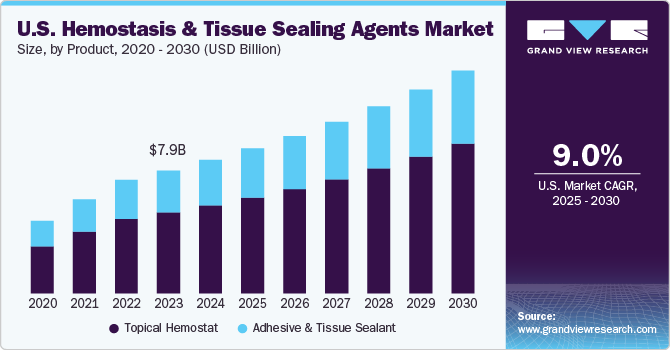
The demand for critical care among older patients has increased due to their vulnerability to slow-healing injuries and wounds. In addition, the prevalence of chronic diseases among adults has significantly risen, with nearly 60% of adult Americans having at least one chronic disease, according to the National Association of Chronic Disease Directors' 2022 report. Chronic conditions, such as diabetes, cancer, and cardiovascular diseases, not only require surgical interventions but also drive the demand for these products. Various chronic conditions, including hernia fixation, diabetes-related complications, spinal injuries, ophthalmic injuries and replacements, urological disorders, and burns, further highlight the need for these specialized medical solutions.
Minimally invasive surgeries in the field of urology are particularly making use of hemostatic solutions, thereby promoting market growth. The highest demand is witnessed in cardiovascular conditions followed by general surgeries. Higher application in cardiovascular disorders is attributed to better clinical results obtained by the use of sealants and hemostats compared to other wound closure techniques. However, a lack of reimbursements for these products may restrain the growth to a certain extent. The increasing cost of surgical procedures and the high price of surgical products are also expected to challenge market growth to an extent.
With a global rise in the incidence of chronic conditions, the volume of surgical procedures is expected to increase. According to the CDC, approximately 150 million Americans are suffering from at least one chronic condition, which leads to the need for surgery. Diabetes as well as neurological, urological, and cardiac diseases are also leading causes of an increase in the volume of surgical procedures. Middle East, Africa, and Asia are witnessing increased incidence of cardiovascular diseases and diabetes. With the growing incidence of chronic diseases, the number of injuries & surgeries is expected to increase, expanding the use of hemostats, adhesives, and tissue-sealing agents.
In addition, the demand for hemostatic and tissue sealing agents is driven by their growing use in minimally invasive urological surgeries and high demand in cardiovascular & general surgeries. These agents are particularly effective in cardiovascular conditions, leading to superior clinical outcomes, reduced scarring, and faster recovery. Their production is subject to strict Class II and III medical device regulations to ensure careful oversights & controls. However, the market faces significant constraints due to potential adverse reactions and complications, which can impact patient well-being.
Market Concentration & Characteristics
The market growth stage is high, and the pace of the market growth is accelerating due to advancements in surgical techniques, increased adoption of minimally invasive procedures, and rising awareness among healthcare professionals regarding the benefits of using these agents in various medical specialties.
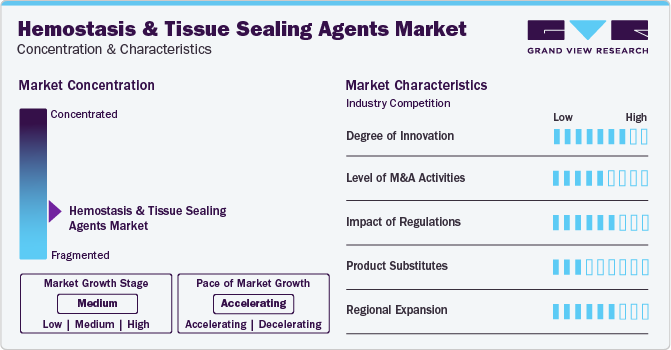
Key players are using various strategies, including new product launches, improving product portfolios, and establishing a global presence to solidify their market positions. For instance, in November 2023, Ethicon, a part of Johnson & Johnson's MedTech division, gained European approval for its Ethizia hemostatic sealing patch. Ethizia helps to treat internal organ bleeding and provides effective results on both sides of the wound.
Degree of Innovation: The market has consistently seen a steady stream of innovation, with companies continually launching novel products and technologies to address the shifting demands of the surgical community. For instance, Terumo's company introduced AQUABRID, an advanced surgical sealant, in the Europe, Middle East, and Africa (EMEA) markets.
Impact of Regulations: Regulations are overseen by regulatory bodies, such as the Food and Drug Administration (FDA) in the U.S. and similar agencies globally. Strict regulatory frameworks assure the safety, effectiveness, and quality standards of products, influencing the industry's production, marketing, and distribution procedures.
Level of M&A Activities: The market is on an upswing due to the imperative need for synergies in R&D, empowering companies to innovate and provide advanced solutions that cater to the evolving requirements of healthcare professionals. Mergers and acquisitions play a crucial role in fostering strategic partnerships, offering companies the chance to leverage economies of scale to intensify market scenarios. For instance, in August 2023, HemoSonics’s Quantra hemostasis system secured an innovative technology contract from Vizient Inc. This contract underscored the system's pioneering approach to hemostasis, indicating a burgeoning acceptance of advanced technology in the market.
Product Substitute: Product substitutes in the hemostasis & tissue sealing agents market are sutures, staples, and energy-based devices that serve as substitutes.
Consolidated market: Key market players, such as Johnson & Johnson, Pfizer Inc., Integra Life Sciences Corporation, Baxter, Smith & Nephew, and BD, hold substantial shares in the market. This dominant presence is due to their well-established brands, extensive distribution networks, and product portfolio. For instance, Johnson & Johnson's split consumer business reflects a more focused healthcare landscape, demonstrating their strategic approach to the market.
Regional Expansion: The market is experiencing robust global expansion due to the growing volume of surgical procedures performed in the region, which has resulted in an increased demand for hemostats.
Product Insights
The topical hemostat segment accounted for the largest market share of 67.44% in 2023. These agents are compatible with conventional treatments, cost-efficient, rapidly absorbable, minimally reactive to tissue, and non-antigenic. Topical hemostats have been widely adopted due to their ability to integrate with existing treatment modalities, offering swift absorbability, minimal tissue response, and a lack of antigenic reactions. The market caters to a range of conditions, including cardiovascular and general surgeries, hernia fixation, diabetes-related complications, spinal injuries, ophthalmic injuries and replacements, urological disorders, and burns. The topical hemostats are further classified into mechanical, active, and flowable hemostats. Hemostasis involves the completion of coagulation, fibrinolysis, and platelet aggregation pathways by the activation of these factors.
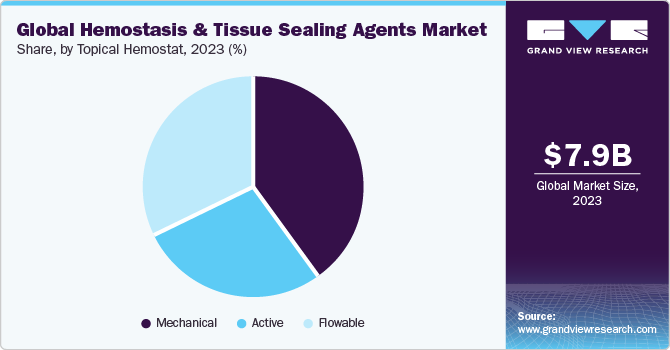
The adhesive & tissue sealant segment is expected to register the fastest CAGR from 2024 to 2030 due to increased adoption of advanced surgical procedures that require efficient tissue-sealing solutions. For instance, innovations in minimally invasive surgeries, such as robotic-assisted procedures in various medical fields like urology, gastroenterology, and gynecology, demand precise tissue sealing to minimize complications and ensure successful outcomes.
Hemostats consist of hemostatic agents and their delivering systems, which may be prefilled syringes or ready-to-use applicators. Adhesives and sealants play a prominent role in controlling blood loss during surgeries. They function by binding with and sealing the damaged tissues. Binding leads to the development of a barrier over the injuries and surgical wounds and helps promote coagulation. The factors promoting demand for sutures include faster procedure rate, minimal invasion, reduced post-surgical infections, and prevention of exudation of other body fluids.
Material Insights
The Gelatin-based topical hemostats segment accounted for the largest share in 2023 due to a rise in surgical interventions and increasing prevalence of chronic conditions, blood disorders played pivotal roles in propelling the market's growth. Gelatin-based hemostats provide effectiveness in controlling bleeding during various surgical procedures. Their biocompatibility and ability to absorb large volumes of blood make them an ideal choice for managing post-surgical bleeding. Moreover, several companies in the market are investing heavily to advance their offerings. For instance, Creilson, Inc., a biotechnology firm based in Brooklyn, successfully secured USD 25 million in a Series A-4 financing round led by Paulson Investment Company. This substantial investment aims to expedite the market entry of Creilson's hemostatic gel.
The collagen-based topical hemostats segment is expected to register the fastest CAGR from 2024 to 2030 due to the increasing adoption of advanced surgical procedures that require efficient tissue-sealing solutions. Collagen-based topical hemostats are biocompatible, have excellent wound-healing properties, and are easy to apply and remove.Furthermore, they provide a controlled release of hemostatic agents, which is beneficial for controlling bleeding during surgical procedures. This makes them an attractive option for both patients and healthcare providers.
Application Insights
The general surgery segment accounted for the largest market share in 2023. This is primarily due to the high volume of surgeries conducted annually, including noncardiac thoracic, abdomen, peripheral vasculature, head and neck, and others. All these surgeries necessitate effective hemostasis to control bleeding and reduce complications. Furthermore, several market leaders are actively investing in the market by launching innovative products and seeking approvals, for instance, in November 2022 Medtrade Products Ltd. received CE certification for its Uterine Hemostatic Tamponade, CELOX. This product is a major innovation that offers quick and efficient management of postpartum hemorrhage, a frequent and serious side effect of childbirth. Such product launches by key players are expected to boost the segment's growth.
The collagen-based topical hemostats segment is expected to register the fastest CAGR from 2024 to 2030 due to the increasing popularity of advanced surgical procedures that necessitate effective tissue-sealing agents. The advancements in minimally invasive surgeries, such as robotic-assisted procedures in fields like urology, gastroenterology, and gynecology. These procedures demand precise tissue sealing to reduce complications and ensure optimal outcomes. Collagen-based hemostats, being absorbable and biocompatible, closely resemble the natural structure of collagen in tissue, making them an ideal choice for these procedures
End-use Insights
The hospitals segment accounted for the largest share in 2023. This is due to the rising number of surgeries globally due to the aging population and the incidence of various diseases leading to their rising adoption by surgeons, further solidifying the market dominance. Hospitals are the primary users of these products, given their extensive use in a wide range of surgical procedures. Effective hemostasis and tissue-sealing agents help manage patient recovery and reduce the risk of complications in surgery.
The ambulatory surgical centers (ASCs) segment is expected to register the fastest CAGR from 2024 to 2030 due to increasing popularity of outpatient surgery centers, which often perform a wide range of surgeries that require effective hemostasis and tissue sealing. These centers typically operate under strict controls and have shorter hospital stays compared to traditional hospitals. This growing trend toward minimally invasive surgeries in ASCs has led to an increased demand for hemostasis and tissue-sealing agents.
Regional Insights
North America dominated the overall global hemostasis and tissue sealing agents market in 2023. This is due to the region has high prevalence of chronic diseases, such as cardiovascular disorders, diabetes, and cancer, which drive the demand for advanced medical solutions, including hemostasis and tissue sealing agents, to manage surgical interventions effectively. For instance, the Cancer Statistics 2022 report projects around 1,918,030 new cancer cases and 609,360 cancer deaths in the U.S., including approximately 350 deaths per day from lung cancer, the leading cause of cancer death. Within the North America market, adhesives and sealants constitute a substantial portion, reflecting their widespread usage and significance in various surgical procedures.
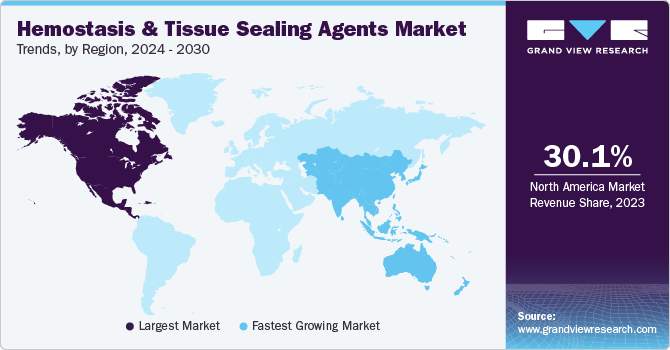
U.S. Hemostasis & Tissue Sealing Agents Market Trends
The U.S. accounted for North America's largest share in 2023, due to its extensive healthcare infrastructure, high adoption rate of advanced surgical techniques, and significant investments in R&D. The emphasis on innovation and access to innovative medical technologies positions the U.S. healthcare system as a key player, driving the region's share in this sector. This growth is further supported by the rising prevalence of chronic diseases, such as cardiovascular disorders, diabetes, and cancer, within the region, leading to a higher demand for advanced medical solutions, including hemostasis and tissue-sealing agents, to manage surgical interventions effectively.
Europe Hemostasis & Tissue Sealing Agents Market Trends
Europe was identified as a lucrative regional market due to the growing aging population, which increases the demand for surgical procedures. The growing need for quicker and more effective healing after surgery drives the demand for hemostasis and tissue-sealing agents in Europe.
UK Hemostasis & Tissue Sealing Agents Market Trends
The UK market is expected to grow over the forecast period due to the increasing adoption of advanced surgical procedures that necessitate efficient tissue-sealing solutions. These innovations in minimally invasive surgeries demand precise tissue sealing to avoid complications and ensure optimal outcomes.
France Hemostasis & Tissue Sealing Agents Market Trends
The hemostasis & tissue sealing agents market in France is expected to grow over the forecast period due to the increasing demand for critical care among older patients on account of their susceptibility to slow-healing injuries and wounds.
Germany Hemostasis & Tissue Sealing Agents Market Trends
The hemostasis & tissue sealing agents market in Germany is expected to grow over the forecast period due to the prevalence of chronic diseases among adults. Disease conditions, such as cancer, cardiovascular diseases, and diabetes, collectively accounted for 44% of the total disability-adjusted life years. In response to this trend, numerous population-based observational studies are focusing on understanding the risk factors associated with these chronic diseases. This factor is driving the higher demand for hemostasis and tissue-sealing agents.
Asia Pacific Hemostasis & Tissue Sealing Agents Market Trends
The Asia Pacific region is expected to witness the fastest growth from 2024 to 2030 due to increasing healthcare expenditure, rising geriatric population, and advancements in healthcare infrastructure. Moreover, a rising volume of surgical procedures and growing awareness of the benefits of hemostasis and tissue-sealing agents in minimizing post-operative complications are contributing to the region's growth.
Japan Hemostasis & Tissue Sealing Agents Market Trends
Japan accounted for the largest share of the Asia Pacific market revenue in 2023. Japan's healthcare sector is highly advanced and has a robust regulatory environment for medical devices, which favors the development and adoption of advanced hemostasis and tissue-sealing agents. Moreover, rising geriatric population leads to a high demand for medical interventions requiring hemostasis and tissue sealing, further driving market growth. Japanese companies have been investing significantly in R&D in this field, leading to the creation of innovative products that meet the market needs.
China Hemostasis & Tissue Sealing Agents Market Trends
The hemostasis & tissue sealing agents market in China is expected to grow over the forecast period due toincreased medical tourism for surgical procedures, which necessitates the use of hemostasis and tissue sealing agents. Alongside this, the rising healthcare expenditure in developing countries, including China, is another factor contributing to the market expansion. As more individuals seek advanced medical treatments abroad, the demand for these essential medical tools is expected to rise.
Saudi Arabia Hemostasis & Tissue Sealing Agents Market Trends
The market in Saudi Arabia is expected to grow over the forecast period due to the increased adoption of advanced surgical procedures that necessitate efficient tissue-sealing solutions. For instance, a rise in minimally invasive surgeries, particularly in urology, where hemostatic solutions are extensively used. This trend is driven by the demand for precise tissue sealing to minimize complications and ensure successful outcomes, thereby promoting market growth.
Kuwait Hemostasis & Tissue Sealing Agents Market Trends
The market in Kuwait is expected to grow over the forecast period due to rising healthcare spending, which has led to an increased demand for advanced medical procedures and related equipment, including hemostasis and tissue-sealing agents. Moreover, advancements in minimally invasive surgeries, such as robotic-assisted procedures in various medical fields like urology, gastroenterology, and gynecology, have led to an increased demand for precise tissue-sealing solutions.
Key Hemostasis & Tissue Sealing Agents Company Insights
The competitive scenario in this market is driven by both established players and new entrants, with innovation, market expansion, and niche specialization being key strategies. Companies are focusing on developing advanced materials and formulations that provide superior performance and patient comfort. In addition, the trend toward personalized medicine is influencing the development of hemostasis and tissue-sealing agents tailored to specific patient needs.
Key Hemostasis & Tissue Sealing Agents Companies:
The following are the leading companies in the hemostasis & tissue sealing agents market. These companies collectively hold the largest market share and dictate industry trends. Financials, strategy maps & products of these hemostasis & tissue sealing agents companies are analyzed to map the supply network.
- Johnson & Johnson
- CryoLife Inc.
- Advance Medical Solution (AMS) Group Plc.
- Cohera Medical Inc.
- Integra Life Sciences Corporation
- Pfizer Inc.
- BD
- Baxter
- HyperBranch Medical Technology
- Biomet Inc
- B Braun Medical Inc
- Smith & Nephew
Recent Developments
-
In November 2023, Johnson & Johnson's MedTech division, Ethicon, introduces Ethizia, a hemostatic sealing patch, obtaining European approval for its launch, marking a significant addition to their medical offerings in Europe
-
In August 2023, HemoSonics’s Quantra hemostasis system received an Innovative Technology Contract from Vizient Inc.
-
In December 2022, Integra LifeSciences successfully concluded the acquisition of Surgical Innovation Associates, marking a strategic expansion in their surgical solutions portfolio. This acquisition enhances Integra's position in the medical device market and reinforces its commitment to advancing surgical innovation
Hemostasis & Tissue Sealing Agents Market Report Scope
Report Attribute
Details
Market size value in 2024
USD 8.67 billion
Revenue forecast in 2030
USD 14.47 billion
Growth rate
CAGR of 8.92% from 2024 to 2030
Actual Data
2018 - 2023
Forecast period
2024 - 2030
Report updated
February 2024
Quantitative units
Revenue in USD million/billion and CAGR from 2024 to 2030
Report coverage
Revenue forecast, company ranking, competitive landscape, growth factors, and trends
Segments covered
Product, material, application, end-use, region
Regional scope
North America; Europe; Asia Pacific; Latin America; MEA
Country scope
U.S.; Canada; UK; Germany; France; Italy; Spain; Denmark; Sweden; Norway; Japan; China; India; Australia; Thailand; South Korea; Brazil; Mexico; Argentina; South Africa; Saudi Arabia; UAE; Kuwait
Key companies profiled
Johnson & Johnson; CryoLife Inc.; Advance Medical Solution (AMS) Group Plc.; Cohera Medical Inc.; Integra Life Sciences Corp.; Pfizer Inc.; BD; Cohesion Technologies Inc.; HyperBranch Medical Technology; Biomet Inc.; Braun Medical Inc.
Customization scope
Free report customization (equivalent up to 8 analysts working days) with purchase. Addition or alteration to country, regional & segment scope
Pricing and purchase options
Avail customized purchase options to meet your exact research needs. Explore purchase options
Global Hemostasis & Tissue Sealing Agents Market Report Segmentation
This report forecasts revenue growth at global, regional, and country levels and provides an analysis of the latest trends in each of the sub-segments from 2018 to 2030. For this study, Grand View Research has segmented the global hemostasis & tissue sealing agents market report on the basis of product, material, application, end-use, and region:
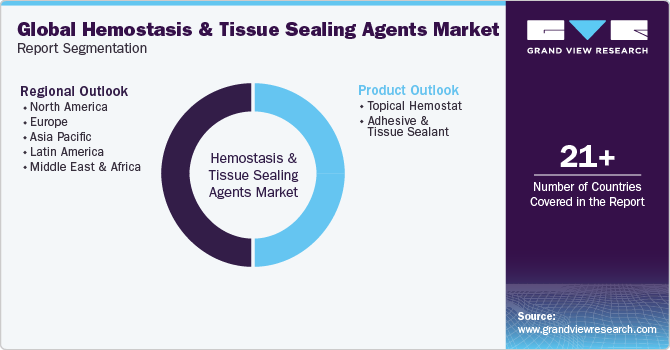
-
Product Outlook (Revenue, USD Million, 2018 - 2030)
-
Topical Hemostat
-
Active
-
Mechanical
-
Flowable
-
-
Adhesive & Tissue Sealant
-
Synthetic Tissue Sealant
-
Natural Tissue Sealant
-
Adhesion Barrier Products
-
-
-
Material Outlook (Revenue, USD Million, 2018 - 2030)
-
Gelatin-based Topical Hemostats
-
Collagen-based Topical Hemostats
-
ORC-based Topical Hemostats
-
Polysaccharide-based Topical Hemostats
-
-
Application Outlook (Revenue, USD Million, 2018 - 2030)
-
General Surgery
-
Neurosurgery
-
Vascular Surgery
-
Cardiovascular Surgery
-
Others
-
-
End-use Outlook (Revenue, USD Million, 2018 - 2030)
-
Hospitals
-
Ambulatory Surgical Centers
-
Others
-
-
Regional Outlook (Revenue, USD Million, 2018 - 2030)
-
North America
-
U.S.
-
Canada
-
-
Europe
-
Germany
-
U.K.
-
France
-
Italy
-
Spain
-
Norway
-
Sweden
-
Denmark
-
-
Asia Pacific
-
China
-
Japan
-
India
-
Thailand
-
South Korea
-
Australia
-
-
Latin America
-
Mexico
-
Brazil
-
Argentina
-
-
MEA
-
South Africa
-
Saudi Arabia
-
UAE
-
Kuwait
-
-
Frequently Asked Questions About This Report
b. The global hemostasis & tissue sealing agents market size was estimated at USD 7.99 billion in 2023 and is expected to reach USD 8.67 billion in 2024.
b. The global hemostasis & tissue sealing agents market is expected to grow at a compound annual growth rate of 8.9% from 2024 to 2030 to reach USD 14.47 billion by 2030.
b. North America dominated the hemostasis and tissue sealing agents market with a share of 33.1% in 2023. This is attributable to the rising prevalence of cardiovascular disorders, diabetes, and cancer in the region.
b. Some key players operating in the hemostasis & tissue sealing agents market include CryoLife, C. R. Bard, B. Braun, and Advance Medical Solutions Group
b. Key factors that are driving the hemostasis & tissue sealing agents market growth include growth in geriatric population and prevalence of chronic conditions
Share this report with your colleague or friend.
![gvr icn]()
NEED A CUSTOM REPORT?
We can customize every report - free of charge - including purchasing stand-alone sections or country-level reports, as well as offer affordable discounts for start-ups & universities. Contact us now
![Certified Icon]()
We are GDPR and CCPA compliant! Your transaction & personal information is safe and secure. For more details, please read our privacy policy.
We are committed towards customer satisfaction, and quality service.
"The quality of research they have done for us has been excellent."





